From surviving to thriving amidst sands, Chinese city fortifies "green Great Wall"
* Through persistent efforts spanning several decades, Zhongwei in the Ningxia Hui Autonomous Region, located at the southern edge of the Tengger Desert, has reclaimed 1.5 million mu (about 100,000 hectares) out of its total 1.68 million mu of desert through afforestation.
* In addition to achieving remarkable progress in desert control, the city has leveraged its remaining 180,000 mu of desert to develop desert tourism, photovoltaic, farming and breeding industries, lifting many out of poverty and improving the livelihoods of locals.
* The city, through its innovative desert control and harnessing practices, stands as a microcosm of the country's ambitious Three-North Shelterbelt Forest Program (TSFP), initiated in 1978 to combat desertification.
YINCHUAN, June 16 (Xinhua) -- Amid the vast expanse of desert in the Shapotou scenic spot, located in northwest China's Zhongwei City, a group of students watch carefully as their tutor demonstrates the technique of paving straw checkerboard, China's remarkable method for sand control.
For these local teenagers, who were excited to receive hands-on experience in making the straw checkerboard, the desert no longer holds a monstrous image. However, for older generations, the desert once represented a life-or-death crisis, as they feared the city might be engulfed by sand.
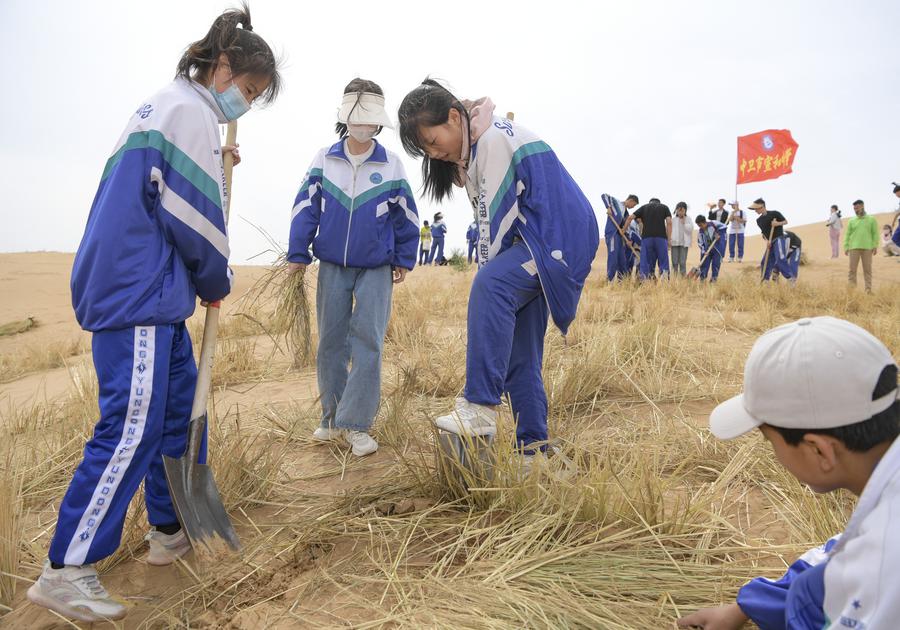
Students learn to pave straw checkerboards in the Tengger Desert in Zhongwei City, northwest China's Ningxia Hui Autonomous Region, May 31, 2024. (Xinhua/Feng Kaihua)
Through persistent efforts spanning several decades, Zhongwei in the Ningxia Hui Autonomous Region, located at the southern edge of the Tengger Desert, has reclaimed 1.5 million mu (about 100,000 hectares) out of its total 1.68 million mu of desert through afforestation. This endeavor has expanded its vegetation coverage from less than 1 percent to 42 percent at present, effectively pushing back the Tengger Desert by 25 kilometers.
In addition to achieving remarkable progress in desert control, the city has leveraged its remaining 180,000 mu of desert to develop desert tourism, photovoltaic, farming and breeding industries, lifting many out of poverty and improving the livelihoods of locals.
As the World Day to Combat Desertification and Drought approaches, it's worth taking a closer look at Zhongwei's journey from battling desertification to thriving amidst the sands.
The city, through its innovative desert control and harnessing practices, stands as a microcosm of the country's ambitious Three-North Shelterbelt Forest Program (TSFP), initiated in 1978 to combat desertification. Serving as a key focal point along the shelterbelt, Zhongwei plays a crucial role as an ecological barrier for north and northwest China, as well as the upper-middle reaches of the Yellow River.
China is among the countries most severely affected by desertification, with desertified areas primarily concentrated in the northwest, north and northeast regions, collectively known as the "three-north." To combat this challenge, China has proposed transforming the TSFP into a robust and enduring "green Great Wall" and ecological security barrier across the country's north.
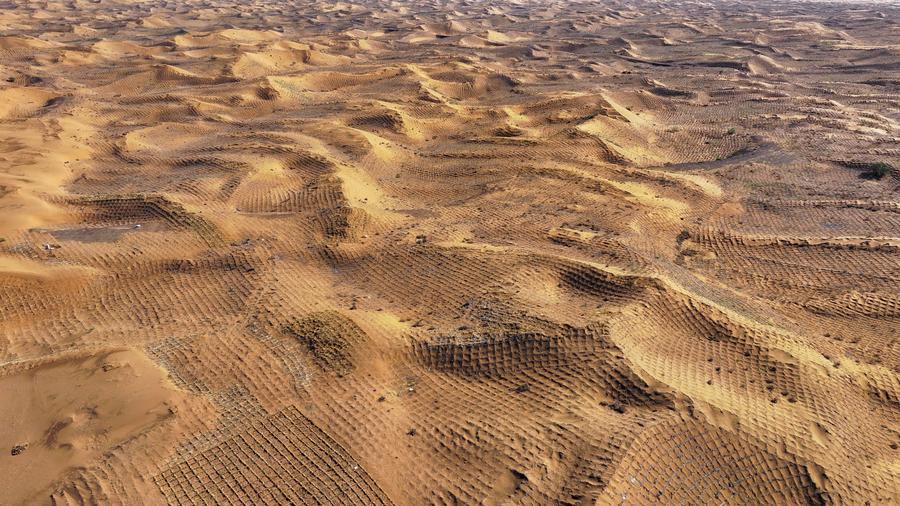
An aerial drone photo taken on May 30, 2024 shows straw checkerboards paved in the Tengger Desert in Zhongwei City, northwest China's Ningxia Hui Autonomous Region. (Xinhua/Feng Kaihua)
BOLSTERING "GREEN GREAT WALL"
"When I was a primary school student, a sandstorm struck one day on my way home from school. The powerful winds blew many of my classmates into a nearby ditch, and some even lost their lives," recounted Tang Ximing, 60, a senior engineer at a state-owned forestry farm in Zhongwei.
While Ningxia is surrounded by desert on three sides, Zhongwei is the hardest-hit city, highly vulnerable to sandstorm catastrophes. In 1958, when a railway that runs through Zhongwei opened to traffic, foreign experts predicted it would be inundated by sand in less than 30 years. The railway was the country's first to run through a desert.
To protect the railway route, the city embarked on a journey of desert mitigation. Scientists at the Shapotou Desert Research and Experiment Station, part of the Northwest Institute of Eco-Environment and Resources of the Chinese Academy of Sciences, along with local residents, developed straw checkerboards to stabilize the sand and prevent dunes from shifting.
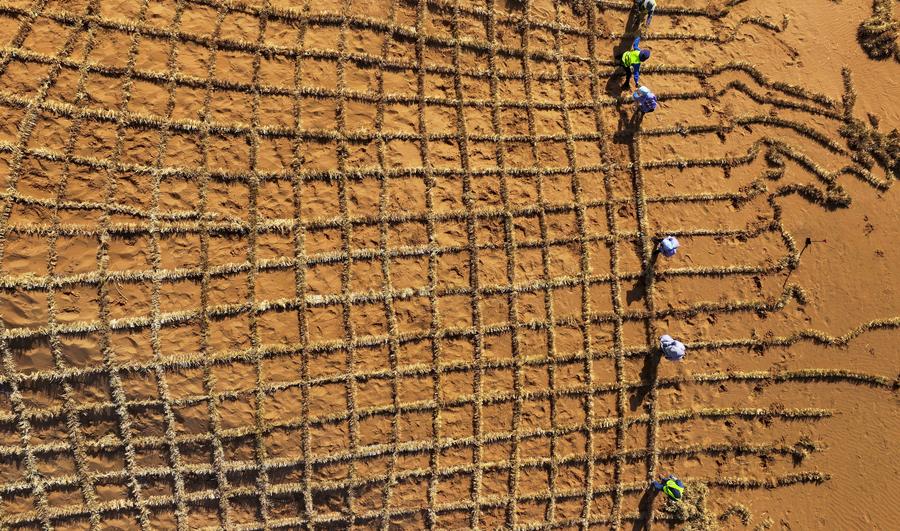
An aerial drone photo taken on May 30, 2024 shows workers paving an enhanced version of straw checkerboards in the Tengger Desert in Zhongwei City, northwest China's Ningxia Hui Autonomous Region. (Xinhua/Feng Kaihua)
By partially burying a layer of straw into the sand, the straw "stands up" as a barrier. When connected into square-shaped grids, these straws form a sprawling "checkerboard" that effectively locks up the sand like a giant mesh. Seedlings planted within these checkerboards have significantly higher chances of survival.
Tang's life is intertwined with the desert. Once eager to escape his sand-ravaged hometown, he was assigned a job as a forestry engineer in Zhongwei after graduating from college. Embracing the challenge, he has dedicated himself to transforming his hometown.
Planting a tree in the desert is extremely challenging, even with the support of straw checkerboards, due to the shallow reach of the root system. Drawing on his experiences, Tang has crafted a steel tool that differs from regular shovels by featuring two horizontal bars at the front tip. This innovative tool enables the planting of seedling roots 50 centimeters deep into the moist sand layer.
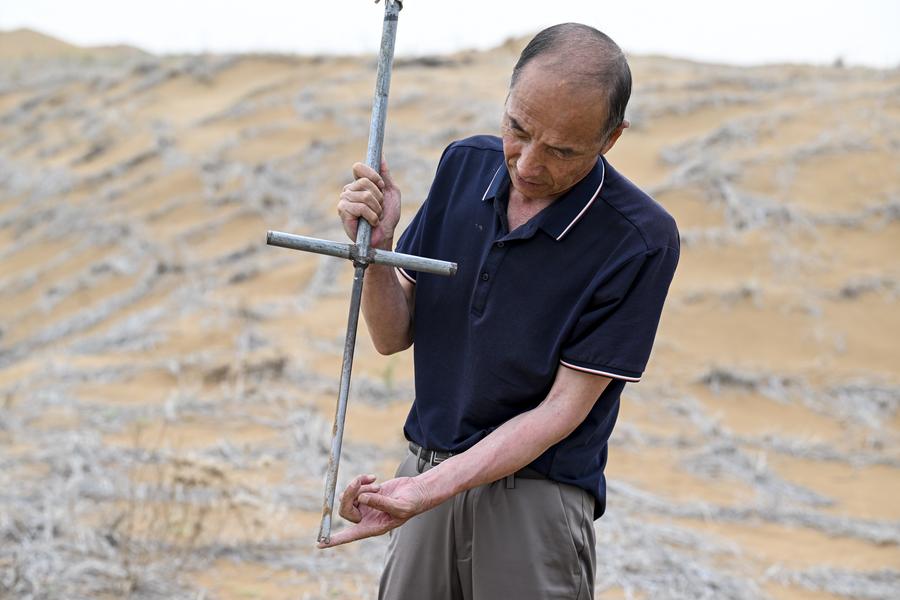
Tang Ximing, a senior engineer at a state-owned forestry farm in Zhongwei, introduces his invention, a steel tool featuring two horizontal bars at the front tip that enables the planting of seedling roots 50 centimeters deep into the moist sand layer, in Zhongwei City, northwest China's Ningxia Hui Autonomous Region, June 1, 2024. (Xinhua/Feng Kaihua)
This simple tool increases the survival rate of afforestation by 25 percent to over 85 percent. It has been widely promoted and used in afforestation projects across other regions in northern China.
Tang has also worked together with researchers to develop an enhanced version of straw checkerboards that can be mass-produced using machinery, thereby extending the service life of these sand barriers.
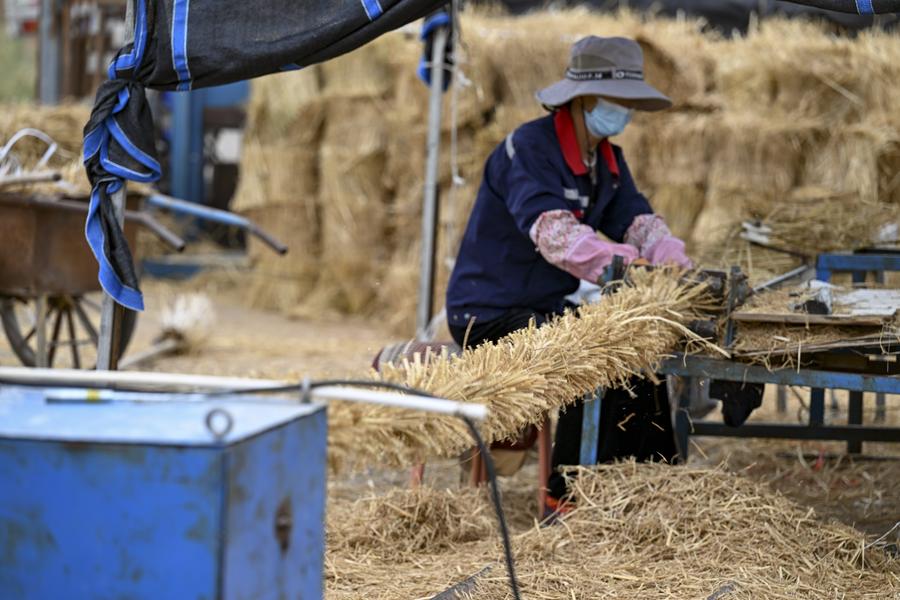
A worker uses a machine to make brush-like straw cable, the material for an enhanced version of straw checkerboards, in Zhongwei City, northwest China's Ningxia Hui Autonomous Region, May 29, 2024. (Xinhua/Feng Kaihua)
Tang is one of many Chinese researchers and grassroots sand-control practitioners who have committed their professional expertise, practical wisdom and strenuous efforts to fortifying the "green Great Wall."
DIGGING GOLD FROM SAND
"I never expected there was such a nice-looking hotel in the middle of a desert," exclaimed Khalifa Mtumwa, a foreign student from Tanzania who visited Zhongwei, referring to a newly opened premium resort hotel in Shapotou scenic spot.
Ranked as China's top desert destination, Zhongwei has made significant strides in enhancing its desert-themed tourism industry. In addition to sightseeing, visitors can enjoy a variety of leisure activities including sand surfing, sand sliding and stargazing, among others.
In another part of the desert, a cattle ranch has been established. "It's dry and well-ventilated in the desert, therefore raising cows in the desert can reduce the incidence rate of some common diseases among cows," said Yang Fei, whose company runs the farm. He added that with a daily output of over 330 tonnes of fresh milk, the farm has become an important source of income for more than 20,000 rural households in 54 local villages.
As industries thrive in Zhongwei by harnessing the resources of the desert, the aim of the TSFP extends beyond desert control to improving livelihoods. Preliminary statistics show that the TSFP has lifted approximately 15 million people out of poverty solely through forestry and fruit cultivation.
Tang is on the brink of retirement, yet his journey is far from over. Having garnered recognition in the field of desert control, he is now sought after to assist in fighting desertification in various regions.
With a packed agenda, Tang aims to combat desertification in the Inner Mongolia Autonomous Region, address coastal sand erosion in South China, and even offer his help to Mongolia.
(Reporting by Tian Ying, Liu Ziling, He Chenyang, Liu Hai, Ma Sijia, Xie Jianwen; video reporters Liu Hai, Ma Sijia, Feng Kaihua, Xie Jianwen; video editors: Wang Houyuan, Zheng Qingbin, Zhu Cong, Liu Ruoshi)
Photos
Related Stories
- China's megacity Shenzhen enjoys fruits of ecological conservation
- Chinese vice premier urges efforts on Three-North Shelterbelt Forest Program
- Nature reserve in SW China's Yunnan sees increasing species richness
- China's space-air-ground monitoring system boosts biodiversity conservation
- Technology gives ecological protection an edge in Hainan Tropical Rainforest National Park
- Researcher devoted to safeguarding ecosystem stability in China's Changbai Mountains
- Ecological conservation efforts yield fruitful outcomes in Qinghai, China
- Marine ecological pasture complex gains development momentum in E China
- Technology enhances ecological protection in China
- China establishes world's largest ecological monitoring network system: MEE
Copyright © 2024 People's Daily Online. All Rights Reserved.









